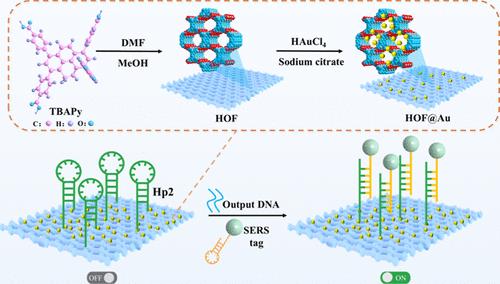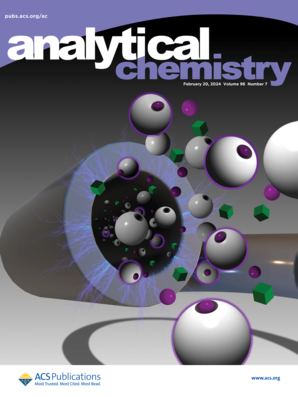Efficient SERS Substrate HOF@Au in Conjunction with DNAzyme-Mediated DNA Walker as a Signal Amplifier for the Ultrasensitive Detection of Lomefloxacin
IF 6.7
1区 化学
Q1 CHEMISTRY, ANALYTICAL
引用次数: 0
Abstract
Lomefloxacin (LOM) is an efficacious antibiotic that might lead to liver damage and other adverse reactions if consumed over an extended period. Hence, this study proposed a DNAzyme-mediated DNA walker as a signal amplifier in combination with a substantial quantity of Au nanoparticle (NP)-loaded hydrogen-bonded organic frameworks (HOFs) as a surface-enhanced Raman scattering (SERS) substrate to accomplish the highly sensitive detection of LOM in food. Crucially, due to their high specific surface area and strong adsorption capacity, HOFs act as an ideal substrate for the in situ growth of a large amount of Au NPs, which exhibit a robust and uniform SERS enhancement. Once the target LOM was presented, the DNAzyme was activated to start the DNA walker and produce single DNA in abundance, which further triggered the catalytic hairpin assembly (CHA) cycle. In addition, the multi-interstitial core−shell structure of Au@Ag@4-nitrobenzenethiol (4-NTP)@Au@Hp3 produced more SERS “hot spots” and significantly amplified the local electromagnetic field, with HOF@Au synergistically strengthening the Raman signal of 4-NTP. Using this principle, this sensor achieved the ultrasensitive detection of LOM through the “signal on” strategy, with a detection limit as low as 4.62 × 10−14 mol/L. This strategy explored a meaningful innovative path for the design of a novel SERS biosensor for the sensitive and selective detection of antibiotics in food.

求助全文
约1分钟内获得全文
求助全文
来源期刊

Analytical Chemistry
化学-分析化学
CiteScore
12.10
自引率
12.20%
发文量
1949
审稿时长
1.4 months
期刊介绍:
Analytical Chemistry, a peer-reviewed research journal, focuses on disseminating new and original knowledge across all branches of analytical chemistry. Fundamental articles may explore general principles of chemical measurement science and need not directly address existing or potential analytical methodology. They can be entirely theoretical or report experimental results. Contributions may cover various phases of analytical operations, including sampling, bioanalysis, electrochemistry, mass spectrometry, microscale and nanoscale systems, environmental analysis, separations, spectroscopy, chemical reactions and selectivity, instrumentation, imaging, surface analysis, and data processing. Papers discussing known analytical methods should present a significant, original application of the method, a notable improvement, or results on an important analyte.
 求助内容:
求助内容: 应助结果提醒方式:
应助结果提醒方式:


